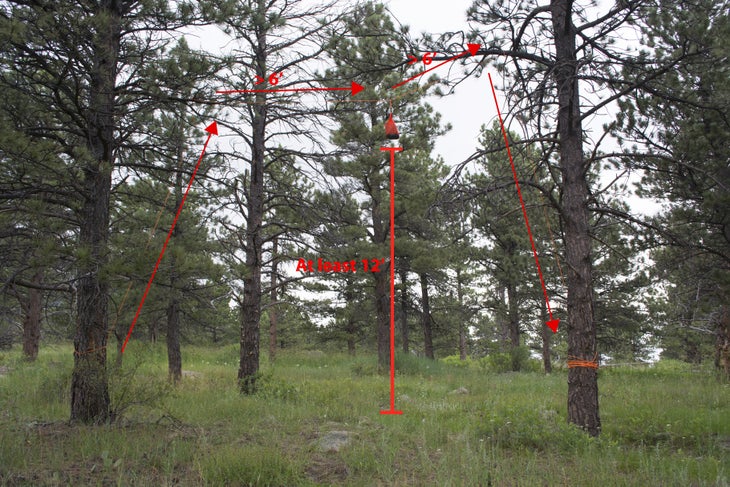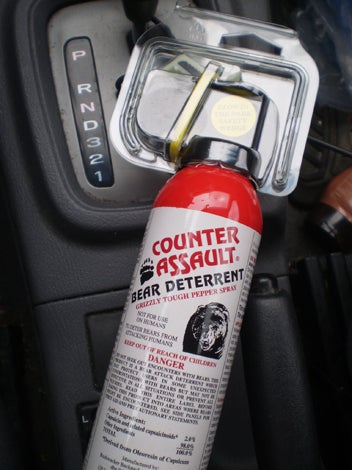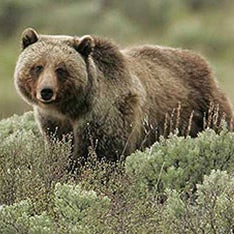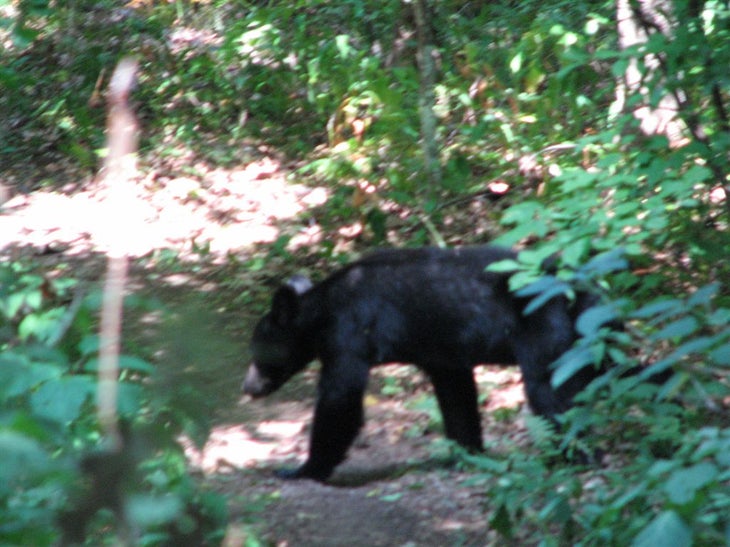Heading out the door? Read this article on the new Outside+ app available now on iOS devices for members! Download the app.
Does anybody really know what to do when they encounter a bear? Sure, there are a lot of myths out there, everything ranging from running down a hill or climbing a tree (because bears can’t do that, “experts” say…). In reality, what you do depends on the situation, the type of bear, and many other factors, Thus, here are some things to look out for and some advice for what to do under dangerous circumstances.
General Bear Safety Tips
Use a Bear Bag (or canister if necessary)

This is probably the original, most important, bear safety tip. A bear bag allows you to keep your food in a safe place while you sleep. It’s a fairly simple process as well. Get some rope and some type of bag (usually a dry sack works great), put your food inside, and check out the characteristics of the above picture to keep your food and yourself safe.
Of course though, some bears (such as those in Yosemite) are smarter than your bear bag technique. To beat this, a bear canister is a much more reliable option. While bulky and awkward to pack, the best bear canisters are proven to be 100% bear proof. Store it a safe distance from camp and everything will be golden.
On a related note: Don’t keep food in your tent, or even eat in your tent for that matter. This will attract not only bears, but other furry critters as well. Seems obvious, but there’s always that one guy…..
Make Your Presence Known
If you are encountering a bear if any type, make yourself known. Be loud. Start yelling, clapping your hands, even throw things. Making yourself really big by waving your arms works as well. You want to scare the bear away and show it that you aren’t afraid of it.
Don’t Run! Don’t Climb!
Honestly, whoever said you could outrun a bear has probably never spent a night in the outdoors in their life. Bears are fast. A black bear can run up to 35 miles per hour. Grizzlies can reach up to 30 miles per hour. The fastest human speed ever? About 27.44 miles per hour by Olympic sprinter Usain Bolt.
Climbing a tree is also a poor idea. Bears love to climb, and they are good at it. At the very least, they are better at it than you. Basically, running or climbing shows weakness and fear, something a bear will literally feed off of.
Bear Spray Could Save the Day

Some people see bear spray as useless, but it is always a good item to have handy; as long as you use it right. Don’t spray every inch of yourself, your pack, you tent, and your campsite with the spray. If anything, that is enticing the bear to come check you out. Use it when the bear is approaching you, mainly as a last line of defense. It is suggested that you spray at a minimum distance of 25 ft between you and the approaching bear. Spraying for 6 seconds will create enough of a barrier for protection.
Bear spray is proven to reduce the length and severity of attacks, but it doesn’t do everything. If you come in close contact with a black bear, you have to prepare to be aggressive and fight back until the spray kicks in. Grizzlies in defense mode respond to the playing dead strategy, so do that until the spray takes effect.
Fun fact: Most encounters with bears involving bear spray results in minor injuries at worst. On the flip side, gun use and bears results more frequently results in death; both for the bear and the people in involved.
Respect Wildlife
A Leave No Trace principle that is so very useful for bear safety. You need to realize that when you go backpacking, you are entering someone else’s home. Just like when you are a guest at a friends’s house, be respectful. Don’t act like you own the place.
To do this, stay on the trail, camp where it is designated, hang your food, don’t act like a fool, and leave the place like you found it. It may seem like a common sense tip, but this principle is one to live by and one that could keep you safe from the harm of a bear attack.
An Obvious Tip
This may make some of you shake your heads, as it is painfully moronic and somewhat comical. Still, it needs to be said. Do not take a selfie with a bear. This has become a real issue, as evidenced by recent incidents in Tahoe. The bear probably won’t want to pose very long with you before trying to rip your face off.
Also, don’t even try to take a picture of the bear if it is anywhere near you. Pocket the camera if a bear is approaching; your face will probably appreciate it.
Essential Bear Safety: Know the Bear
It is vital to know whether you are dealing with a black bear or a grizzly/brown bear, but knowing the difference is not always the easiest thing to do. Here are some facts on what to look for when identifying the beast of the woods.
Grizzly Characteristics

Habitat: In North America, Grizzlies are generally found in Western Canada, Alaska, Wyoming, Montana, Idaho, and a smaller population in Washington. Historically though, they have been found in a range from California to Ohio. They can live in dense forests, arctic tundra, and even open plains. On that note, they can be found in many places.
What they look like: Grizzlies can grow as tall as 8 feet and weigh up to 800 pounds. They are usually brown, but can have white tipped or “grizzled” fur.
Skills: They are fast at up to 30 miles per hour. When they are younger they are great climbers, although their large size gets in the way as they grow older so that skill tends to fade. They are very adaptive and hibernate during the winter months, storing huge amounts of body fat to survive the cold months.
Black Bear Characteristics

Habitat: Black bears are prominent throughout the northeast and can be found in the Appalachians, the northern mid west, the Rocky mountains, the west coast and Alaska. They occupy many of the forested regions in these areas,
What they look like: The name “Black Bear” can be quite misleading due to their range of colors. They can be black, silvery blue, blue-black, brown, cinnamon, and even white (although very rare). They are much smaller than grizzlies, ranging from 5 to 6 feet long and 200 to 600 pounds.
Skills: They are even faster than grizzlies, reaching speeds up to 35 miles per hour. They are also much better climbers, thanks to their smaller size. If you disturb a black bear during the winter months, it will wake up. This is because they are not true hibernators, although they do not eat or drink during winter.
Grizzly Bear Safety
The “Play Dead” Technique
This strategy is good for dealing with grizzlies who are in defense mode, i.e. to protect their cubs. If they feel you are not a threat (which you wouldn’t be if you were dead), then they will not mess with you generally.
Of course, this is a generalities, and as with all generalities, there are exceptions. Really, if you use your bear spray properly, alert the bear of your presence, and show respect, this method shouldn’t be needed. Still, if you find yourself being attacked by a grizzly, this technique is useful.
How do you play dead, you may ask? Lay face down, legs spread, hands clasped around your neck, staying still while the bear mauls your backpack. You may lose out on a nice pack and whatever other goodies you had stowed away, but at least you’ll be alive to replace all of it.
Black Bear Safety
Fight For Your Life
Black bears may attack you even if you aren’t presenting any threat to their cubs. This means you must fight back. Playing dead will likely result in actually being dead. Punch, kick, elbow—do anything you can to get the bear off of you. This is a matter of life and death.